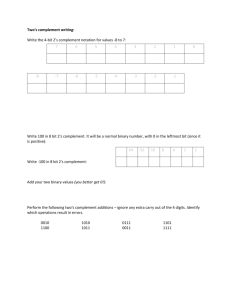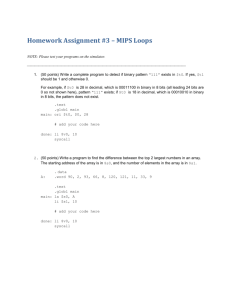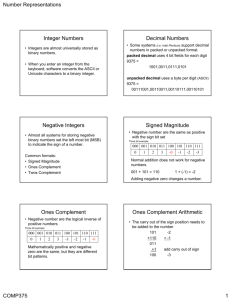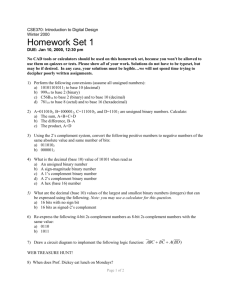Introduction to Computers and Programming Numeric Values 25
advertisement
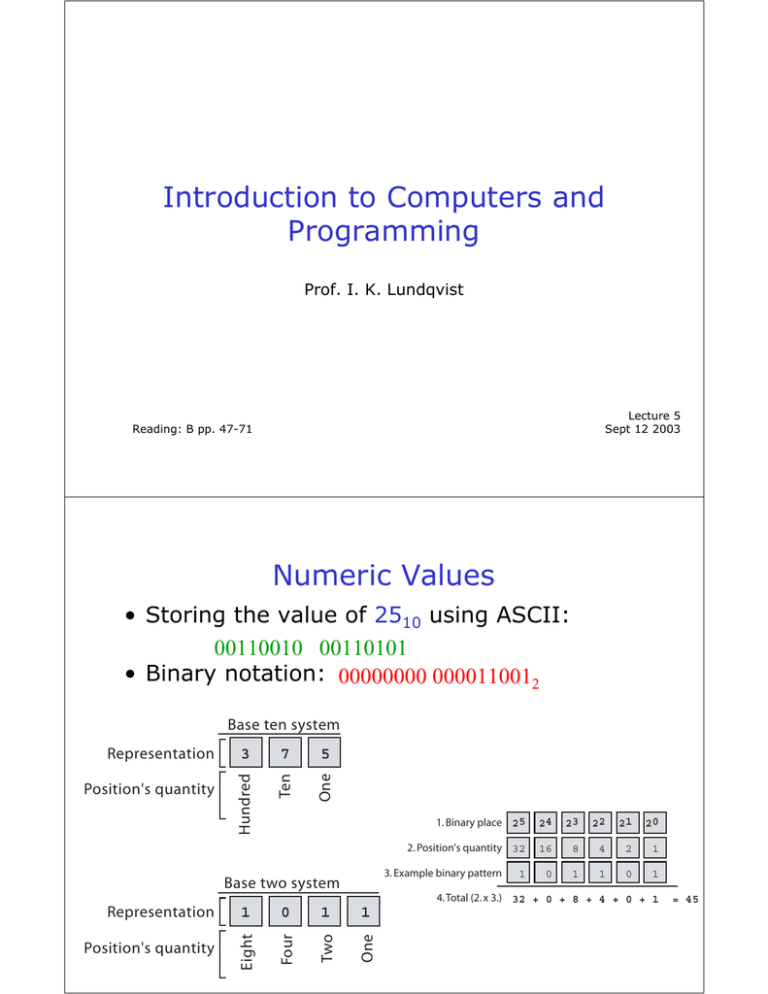
Introduction to Computers and Programming Prof. I. K. Lundqvist Lecture 5 Sept 12 2003 Reading: B pp. 47-71 Numeric Values • Storing the value of 2510 using ASCII: 00110010 00110101 • Binary notation: 00000000 0000110012 7 5 One Position's quantity 3 Ten Representation Hundred Base ten system 1. Binary place 25 24 23 22 21 20 2. Position's quantity 32 16 8 4 2 1 0 1 1 0 1 3. Example binary pattern Base two system 1 1 0 1 1 Position's quantity Eight Four Two One 4. Total (2. x 3.) 32 + 0 + 8 + 4 + 0 + 1 Representation = 45 Finding Binary Representation of Large Values 1. Divide the value by 2 and record the remainder 2. As long as the quotient obtained is not 0, continue to divide the newest quotient by 2 and record the remainder 3. Now that a quotient of 0 has been obtained, the binary representation of the original value consists of the remainders listed from right to left in the order they were recorded 2 0 R1 1 2 1 R1 3 2 0 R0 6 6 R1 2 13 1 1 0 1 The Binary System • Decimal: Position represents a power of 10 – 538210 = 5x103 + 3x102 +8x101 +2x100 • Binary: Position represents a power of 2 – 10112 = 1x23 + 0x22 + 1x21 + 1x20 = 8 + 0 + 2 + 1 = 1110 • Binary addition bit number • A byte bit value 7 6 5 4 3 2 1 0 0 1 0 1 0 0 1 1 32 16 8 4 2 128 64 1 Representing Negative Numbers • Using one byte, any suggestions for representing negative numbers? – E.g., 000100112 = 1910. How to represent 1910 in binary? • Reserve 1 bit (#7) for sign, 7 bits for number (sign magnitude) – 000000012 = 110 – 000100112 = 1910 100000012 = -110 100100112 = -1910 Representing Negative Numbers • One’s complement – invert each bit – 000100112 = 1910 111011002 = -1910 – 010: 000000002 and 111111112 • Two’s complement – invert each bit and add 1 – 000100112 = 1910 111011012 = -1910 – Try to negate 0: • 010 = 000000002 • invert: 000000002 Æ 111111112 • add 1: 111111112 + 000000012 = 000000002 Two’s Complement Notation Systems Bit Pattern Value Represented Bit Pattern Value Represented 011 3 0111 7 010 2 0110 6 001 1 0101 5 000 0 0100 4 111 -1 0011 3 110 -2 0010 2 101 -3 0001 1 100 -4 0000 0 1111 -1 1110 -2 1101 -3 1100 -4 1011 -5 1010 -6 1001 -7 1000 -8 Addition Problem in base ten 3 + 2 -3 +-2 7 +-5 Problem in Answer in two's complement base ten 0011 + 0010 0101 5 1101 + 1110 1011 -5 0111 + 1011 0010 2 • Example: we are using 8 bit two's complement and have the problem 97-81. 97 0 1 1 0 0 0 0 1 -81 +1 0 1 0 1 1 1 1 16 0 0 0 1 0 0 0 0 Summary: One’s/Two’s Complement • Note that in sign magnitude and in one's complement there are two possible representations of 0, and we can represent every integer n with -( 2k -1) d n d 2k -1 with a k-bit field. • With two's complement there is only one representation of 0, and we can represent the integers n with -2k d n d 2k -1. • The most significant advantage of two's complement is the fact that subtraction can be performed with addition circuitry. The Problem of Overflow • Overflow: when a value to be represented falls outside the range of values that can be represented. • An overflow is indicated if the addition of two positive values results in the pattern for a negative value or vice versa. • Remember: small values can accumulate to produce large numbers. Fractions in Binary • Each position is assigned a quantity of twice the size of the one to its right. • 101.101 = ? 1. Binary place 22 21 20 2-1 2-2 2-3 1/2 1/4 1/8 2. Position's quantity 4 2 1 3. Example binary pattern 1 0 1 . 4. Total (2 x 3) 10.001 + 100.000 111.001 1 0 1 4 + 0 + 1 + 1/2+ 0 +1/8 = 5 5/8 Floating Point representation • To represent a floating point number the number is divided into two parts: the integer and the fraction – 3.1415 has integer 3 and fraction 0.1415 • Converting FP to binary: – Convert integer part to binary – Convert fraction part to binary – Put a decimal point between the two numbers Floating Point representation • Assume 12 bits to represent the integer part and 4 bits to represent the fraction: 71.3425 = +1000111.0101 Normalization • To represent +1000111.0101 – Store sign, all bits, and the position of decimal point •Instead we use Normalization Move the decimal point so that there is only one 1 to the left of the decimal point. To indicate the original value of the number, multiply by 2e where e is the number of bits that the decimal point moved, positive for left movement, negative for right movement Store: The sign The exponent Sign bit Exponent Mantissa Bit positions The mantissa Excess (or bias) Notation • Alternative to two’s complement used to store the exponent for floating point numbers. Bit Pattern Value Represented 111 3 110 2 101 1 100 0 011 -1 010 -2 001 -3 000 -4 With 3 bits we have excess 4 (=23-1) Excess (or bias) Notation Bit Pattern Value Represented 1111 1110 1101 1100 1011 1010 1001 1000 0111 0110 0101 0100 0011 0010 0001 0000 7 6 5 4 3 2 1 0 -1 -2 -3 -4 -5 -6 -7 -8 With 4 bits we have excess 8 (=24-1) With N bits we have excess 2N-1 We add the magic number, 2N-1, to the integer, change the result to binary, and add 0’s (on the left) to make up N bits. FP Representation • The standard IEEE representation for FP uses 32 bits for single-precision format: – 1 bit sign – 8 bits exponent (excess 127 = 28-1-1) – 23 bits mantissa • Representation. Store the: – Sign as 0 (positive), 1 (negative) – Exponent (power of 2) as excess127 – Mantissa as an unsigned integer Example: FP Representation • Consider a 16-bit representation with – 1 bit sign – 5 bits exponent (excess 16 = 25-1) – 10 bits mantissa • 0 10011 1101100000 – The sign 0 represents positive – The exponent 10011 = 1910 represents 3 – The mantissa is .1101100000 (1 to left of . is not stored, it is understood) Coding the value 2 5/8 2 5/8 Original representation Base 2 representation 1 0 . 1 0 1 Raw bit pattern 1 0 1 0 1 Lost bit Sign bit Exponent Mantissa Truncation Errors
